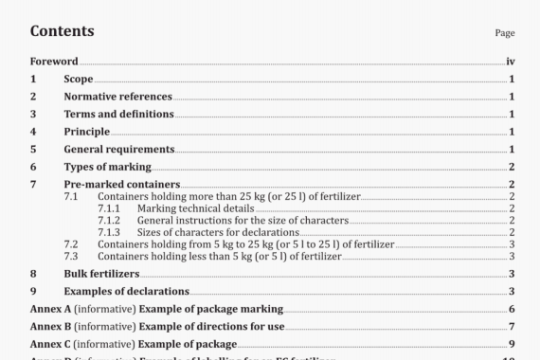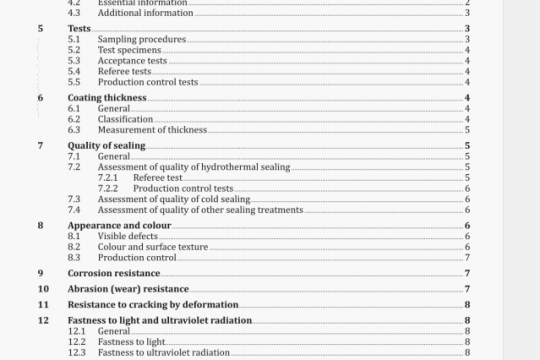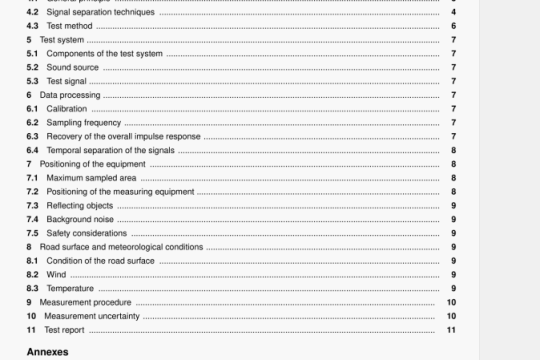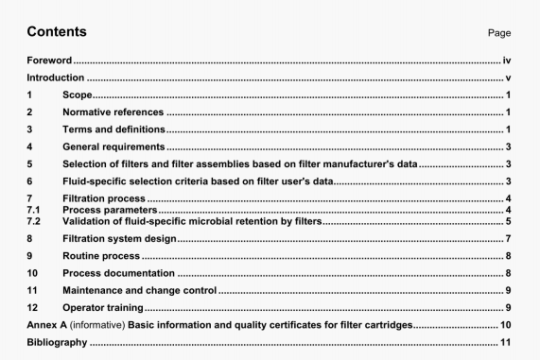ISO 6321:2002 pdf download
ISO 6321:2002 pdf download.Animal and vegetable fats and oils —Determination of melting point in opencapillary tubes (slip point).
Melt a portion of the test sample as rapidly as possible to at least 5°C, but not more than 10°C, above the temperature at which it is completely melted.
Dip two capillary tubes (5.1) into the melted test sample until columns of fat 10 mm ± 2 mm long are obtained. Immediately after filling the tubes, wipe them quickly with absorbent tissue to remove any fat adhering to the outer surfaces of the tubes. Immediately place the filled capillary tubes for a few seconds against a beaker filled with ice so that the fat solidifies.
Place the tubes in the cooling bath (5.4) for 5 mm.
Continue in accordance with 8.3.
8.2 Preparation of the capillary tubes for method B
Melt a portion of the test sample as rapidly as possible to at least 5°C, but not more than 10°C, above the temperature at which it is completely melted.
Cool the melted test sample, with occasional stirring, until its temperature is 32 °C to 34 °C and then stir continuously with the stirrer (5.3), allowing the fat to cool until the first signs of cloudiness appear.
Continue stirring by hand until the fat has a pasty consistency and then transfer the fat to a 100 ml beaker at
17°C±2°C.
Store the fat at this temperature for a minimum of 24 h.
Push four capillary tubes (5.1) into the conditioned fat until a column of fat 10 mm ± 2 mm long is obtained in each tube. Wipe the tubes quickly with absorbent tissue to remove any fat adhering to the outer surfaces of the tubes. Store the tubes at 17°C ± 2 °C until required.
8.3 Determination
8.3.1 Avoiding transfer of body heat to the fat, attach two capillary tubes prepared for method A (8.1) or for method B (8.2) to the thermometer (5.2) using small rubber bands (or by any other suitable means such as a rubber ring) so that the columns of fat are located at the lower ends of the tubes and lie adjacent to the bulb of the thermometer.
8.3.2 Fill the water jacket [5.5 a)] and the water heater [5.5 b)] with previously boiled water cooled to 15 °C. Clamp or suspend the thermometer with the attached capillary tubes centrally in the water jacket so that the lower ends of the capillary tubes are 30 mm below the surface of the water.
8.3.3 Operate the heating apparatus (5.5) so that a slow stream of water passes through the water jacket, regulating the heating so that the rise in temperature of the water, as measured by the thermometer in the water jacket, is about 3 °C/min to 4 °C/min for method A and 1 °C/min for method B.
8.3.4 For each of the two capillary tubes, note the temperature value indicated by the thermometer immediately the fat starts to rise in the tube.
8.3.5 Note the arithmetic mean of the two readings obtained. For method A, take this arithmetic mean as the result of one determination.
8.3.6 For method B, repeat the operations described in 8.3.1 to 8.3.3 using the remaining two capillary tubes (8.2), decreasing the rate of temperature rise to 0,5 °C/min when the water temperature is within 5 °C of the mean reading as the result of one determination.
8.4 Number of determinations
Carry out two determinations on the same test sample [i.e. to obtain two mean readings for method A (8.3.5) and two final mean readings for method B (8.3.6)].
9 Expression of results
Take as the result the arithmetic mean of the two determinations.
Express the result to the nearest 0,1 CC.
10 Precision
10.1 Interlaboratory tests
Details of interlaboratory tests on the precision of the method are summarized in annex B. The values derived from these interlaboratory tests may not be applicable to concentration ranges and matrices other than those given.
10.2 Repeatability
The absolute difference between two independent single test results, obtained using the same method on identical test material in the same laboratory by the same operator using the same equipment within a short interval of time, will in not more than 5 % of cases be greater than 0,5 °C for method A and 1,0 °C for method B.
11 Test report
The test report shall specify:
— all information necessary for the complete identification of the sample;
— the sampling method used, if known;
— the test method used (i.e. ISO 6321, method A or method B);
— all operating details not specified in this International Standard, or regarded as optional, together with details of any incidents which may have influenced the test result(s);
— the test result(s) obtained, or, if the repeatability has been checked, the final result obtained.




